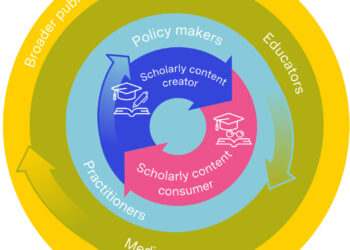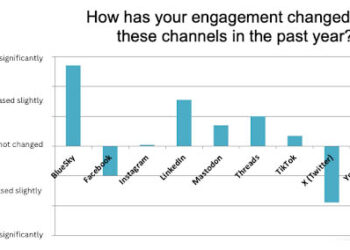
As I mentioned previously on the Kitchen, I am currently working with Ithaka S+R on a project to, among other things, assess Amazon’s role in book sales to libraries. My colleagues on this project, my fellow Kitchen chef Roger Schonfeld and Liam Sweeney, have been assembling a huge amount of data, which is likely to yield a number of unanticipated insights into library purchasing — and, not incidentally, a stream of blog posts from Roger and me. From my point of view (Ithaka is exploring this from a different angle), one such insight emerged unexpectedly at AAUP this year, when Roger and Liam presented some slides on the principal library vendors. One slide was of the leading vendors of serials (including journals), the other of vendors of books. Surprise! The top vendor of both formats is one and the same. That uncomfortable feeling you get when you look at this information? You are witnessing the unfolding of a gatekeeper strategy by EBSCO, whose apparent aim is to mediate as much commerce as possible between publishers and academic libraries.
Some background. First, gatekeeper strategies have a long and illustrious history, and sometimes they play out with enormous force and implications. If you want an illustration of such a strategy in action, think about how you get Internet access (or cable) in your home. Most American households have only one or two options for such access, and the providers of these pipes do everything they can to dominate, if not control in their entirety, the services, including media, coming into the home. If you think Verizon, AT&T, and Comcast are operating in your interest — in the interest of the free flow of information in a democratic society — we have nothing to discuss. These telecommunications companies emerge as gatekeepers by exploiting the physical infrastructure, which is costly to install. (Kudos to Google for its Project Loon, which is an experiment in providing Internet access via hot-air balloon. A friend of mine is working on that project; he tells me it is by far the most ambitious and sophisticated project he has ever been associated with.)
EBSCO and other gatekeeper wannabes (ProQuest is the obvious name that comes to mind, especially since its acquisition of the Coutts services from Ingram) don’t own pipes or bricks and mortar, but are focused instead on “softer” things such as popular user interfaces. If we know nothing else about the Internet, we know at least this: the rich get richer. This is what is known as the law of increasing returns: the more people who use an interface, the greater the pressure and proclivity for others to use that interface. When a library says to a publisher, “We don’t want to buy things directly from you; please place your products into the program of Aggregator X,” we can see how publishers can begin to gasp for air.
A second point of background: Whenever you work on a project that generates a lot of data, some of the most interesting results were not anticipated when the project started out. This Ithaka project started with the aim of determining Amazon’s market share in the academic library market, but now it is revealing fascinating information about library purchasing overall and about university presses in particular. There is a business point to be made about this: Invest in capabilities, not in outcomes. There can be no outcomes without capabilities, but controlling capabilities can lead to numerous beneficial and unanticipated outcomes. A corollary to this: Think hard before you outsource anything. When you outsource something, you are not only pushing a cost outside your organization; you are also pushing out a suite of future (and unknown) outcomes.
I am going to forego describing the methodology of the Ithaka project, as all that information will be made available in the fall when the project is completed, but for the purposes of this post, the key thing is that Ithaka has obtained access to the comprehensive purchasing records of several major research libraries, and more libraries are coming on board now, which will ultimately lead to the largest database of library purchasing data that is not in commercial hands. What these records show is that even just a small set of research libraries purchase materials from over 400 vendors. There is of course a Long Tail: After we get beyond the biggies of EBSCO, Elsevier, Wiley, and their ilk, we come to a great number of smaller entities.
And this is where things get interesting: Is 400 a big number or a small one? It depends on where you sit. I would say that it is a tiny number, especially if most libraries route most purchases through just a single vendor, relying on the Long Tail only for rare and internationally specialized purchases, which is Ithaka’s working hypothesis. I know that there are thousands of publishers that cannot get a hearing with libraries. But a library may say the opposite: By reducing the number of vendors, the cost of administration of purchasing drops, leaving more money for higher value services. The question for everybody, though, is that now that we know what a gatekeeper strategy can lead to in consumer telecommunications, shouldn’t we be doing everything possible to forestall such a strategy from being implemented in academic libraries? Ironies abound, of course, as they always do. Google–that behemoth of Silicon Valley–is trying to break up the telecommunications gatekeepers, and Amazon–warm and fuzzy Amazon–is attempting to break into the academic library market, at the expense of the gatekeeping incumbents. These are battles of titans.
EBSCO became the leading provider of books to libraries with its recent acquisition of YBP, thus pairing YBP’s market-leading book service with EBSCO’s leading position in serials — which itself was built in part through acquisitions. This is undoubtedly a smart move for EBSCO and it may be a good thing for YBP (EBSCO is a strong company). At least in the short term it may be a good thing for libraries, which will benefit from efficiencies. For book publishers this is a terrible development. The folks at EBSCO may be the nicest people in the world and send their kids to the same church picnics as the executives at AT&T and Comcast. The problem is that a good heart is nothing when brought into the context of the imperatives of the economy, which, as Woodrow Wilson remarked many years ago, is heartless (“The truth is, we are all caught in a great economic system which is heartless”).
So even assuming that gatekeeping was not EBSCO’s aim but an accidental byproduct of the acquisition of RoweCom, YBP, and others (and if you believe that . . . ), how will the economy direct EBSCO’s actions? We should look for the assertion of pressure both upstream and downstream — upstream to publishers, who will have to give up increasing margin to participate in EBSCO’s programs, and downstream to libraries, which will face higher prices as EBSCO’s market share grows. We should also look at how EBSCO chooses to integrate its recent acquisitions, both with one another and with its content platforms, discovery tools, and other products and services.
What we should expect to see is every alert publisher striving to get around the gatekeeper. If you are a big publisher, the strategy is to get even bigger and to be able to get libraries’ direct attention. If you are a small publisher, the strategy is to make a deal with a larger publisher. We have already seen this pattern with scholarly journals in droves, but the pattern is not yet repeating itself with books – perhaps because the monograph publishing community has not yet found the right strategy for achieving scale. The much-maligned Big Deal is thus in part an anti-gatekeeper strategy. Does it still seem like such an evil thing when viewed from that perspective?
Discussion
8 Thoughts on "The Gatekeeper Strategy in the Library Market"
One wonders at which point libraries will become less of a market for the likes of EBSCO (or Proquest) as discovery and other customised tools are developed for direct to user. More libraries marginalised than library markets, perhaps. This oligopoly in the library supply market mirrors that of academic publishing. Perhaps they are not that far from meeting?
But some aggregators, like Project Muse, were founded by institutions that share the mission-driven aims of non-profits, and Muse of course was a co-development of the press and library at Johns Hopkins, so a library had a major role right from the beginning. Surely this must make a difference in how it pursues its gatekeeper role. As a press director I felt much more comfortable dealing with Project Muse than with EBSCO, though we used both services for our journals.
I like Joe’s observation that the Big Deal is a sort of anti gate-keeper strategy. While some libraries actually pay for big deals through an agent like EBSCO, big deal publishers have a much more direct relationship with libraries than most publishers. Similarly, gatekeepers (particularly aggregators and subscription agents like EBSCO) can be see as a strategy to fend off over-reliance on big deals. Using an agent provides some of the same sorts of efficiencies for a library as a Big Deal (single invoice, single point of contact for service, lumped together budgeting) while still supporting a larger network of publishers.
At Elsevier my team defined and executed the big deal, nit just because we needed to protect a current franchise, but to enable us to define better products through direct customer interaction and to help libraries gain a bigger impact in their universities. We operated in a difficult situation because the library leadership had a short term orientation towards gaining better control of our pricing and making tactical advances. The bigger issue at stake was the strategic use of information in higher education and research and publishers and libraries found it difficult to align and make progress. EBSCO was able on a tactical scale to leverage this strategic situation very well. The key question today is still the same: Is the community truly generating better solutions and higher value to students and researchers?
And there was no consideration that by instituting the big deal Elsevier was putting itself in a better position to leverage its power in the marketplace and gain greater market share by crowding out smaller publishers who were in no position to make any comparable offer to libraries?And there was no talk about this being a good strategy for launching new journals that could be folded into the big deal and not have to stand market pressure directly on their own but be protected by the umbrella of the big deal?
As I mentioned a key consideration was protection of our franchise in the short run, which is tactical. The two considerations you mention are both tactical and may work short term, but the key driver has always been strategic: Real understanding of the opportunities in our client organizations, bringing more value to our customers. Talking about new journals is having the wrong dialogue. The real question is: How can we help education and research move forward and re-imagine the roles of publishers and librarians? Personally I have thoroughly enjoyed working with the true leaders and innovators in the library world, but there are still too little of those !


